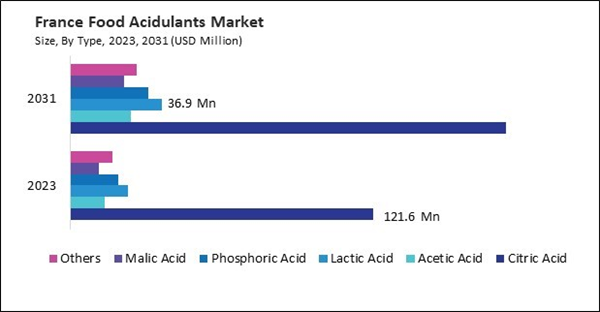Acetic acid, a staple in the food acidulants market, serves multiple purposes in the food and beverage industry. Its primary use lies in enhancing flavors, acting as a preservative, and regulating pH levels in various products. This clear, colorless liquid, commonly found in condiments like vinegar, pickles, and salad dressings, imparts a tangy taste while extending shelf life. Its natural preservative properties inhibit bacterial and fungal growth, ensuring food safety and quality. Therefore, the Germany market consumed 40.63 tonnes of Acetic acid in 2023.
The Germany market dominated the Europe Food Acidulants Market by Country in 2023, and is forecast to continue being a dominant market till 2031; thereby, achieving a market value of $485.1 Million by 2031. The UK market is exhibiting a CAGR of 3.8% during (2024 - 2031). Additionally, The France market is projected to experience a CAGR of 5.6% during (2024 - 2031).
The adoption of food acidulants has been widespread across the food and beverage industry, driven by several factors highlighting their importance and versatility. Food acidulants are integral to formulating various food and beverage products, ranging from carbonated beverages and confectionery to processed meats and dairy items. Their widespread usage across diverse food categories underscores their importance in modern food processing.
Acidulants play a crucial role in enhancing the flavor profiles of various food and beverage products by imparting tartness or sourness. This is particularly evident in carbonated beverages, where acidulants contribute to the characteristic tangy taste that consumers expect. Acidulants help regulate pH levels in food products, contributing to their stability and preservation. By creating an acidic environment, acidulants inhibit the growth of spoilage-causing microorganisms, extending the shelf life of processed foods such as canned fruits, sauces, and pickles.
The bakery sector requires acidulants for various purposes, including dough conditioning, flavor enhancement, and pH regulation. According to the Government of Poland, Poland is the 5th largest producer of bakery products in the European Union. Every fifth food company in Poland is involved in the production of bakery products. The bakery industry accounted for almost 5% of the domestic food production in 2022. Likewise, acidulants are used in various meat products, such as sausages, processed meats, marinades, and cured meats. As per the Eurostat, at the end of 2022, there were 134 million pigs, 75 million bovine animals, and 70 million sheep and goats in the EU. The EU’s pig meat production in 2022 was 1.3 million tons. The EU produced a provisional 6.6 million tons of bovine meat (beef and veal carcasses) in 2022. Therefore, the rising bakery industry and increasing regional meat sector drive the market's growth.
List of Key Companies Profiled
- Tate & Lyle Plc
- Brenntag SE
- Univar Solutions, Inc.
- Archer Daniels Midland Company
- Jungbunzlauer Suisse AG
- Cargill, Incorporated
- Corbion N.V.
- Bartek Ingredients Inc. (TorQuest Partners)
- FBC Industries Inc.
- Hawkins Watts Limited
Market Report Segmentation
By Application< (Volume, Tonnes, USD Billion, 2020-2031)- Beverages
- Bakery & Confectionery
- Dairy & Frozen Desserts
- Meat Industry
- Others
- Citric Acid
- Acetic Acid
- Lactic Acid
- Phosphoric Acid
- Malic Acid
- Others
- Germany
- UK
- France
- Russia
- Spain
- Italy
- Rest of Europe
Table of Contents
Companies Mentioned
- Tate & Lyle Plc
- Brenntag SE
- Univar Solutions, Inc.
- Archer Daniels Midland Company
- Jungbunzlauer Suisse AG
- Cargill, Incorporated
- Corbion N.V.
- Bartek Ingredients Inc. (TorQuest Partners)
- FBC Industries Inc.
- Hawkins Watts Limited
Methodology

LOADING...









